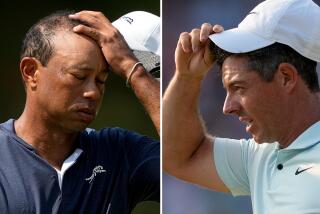Augusta Has a Growth Spurt
AUGUSTA, Ga. — The green jacket Tiger Woods slipped over his shoulders after winning his first Masters was a size 42 long. It was a loose fit for the 21-year-old champion, but that was by design.
“A lot of the guys say they get larger as they get older,” Woods said.
The same holds true for Augusta National Golf Club.
About a month after Woods walked away from the Masters with his fourth straight major championship, the bulldozers moved in. Half of the 18 holes were lengthened. Bunkers were stretched and deepened. Tees were shifted to sharpen the doglegs.
The result?
A golf course built 70 years ago on a former nursery is all grown up.
“Every year, you always see small adjustments,” two-time Masters champion Ben Crenshaw said. “This year, we’re in for something entirely different.”
Woods is the defending champion when the 66th Masters begins this week. Jack Nicklaus has a bad back and will not play for only the second time in 44 years. Greg Norman has been offered another chance at a green jacket. Phil Mickelson still hasn’t won a major.
Everything else about this year’s Masters is uncertain. The anticipation building for this year’s tournament is not so much who will win, but how.
“You’ve got to really play well now to break 70,” Ernie Els said. “If we have a little bit of weather come through ... you could see even par winning if it’s really tough.”
Augusta still blends the majestic beauty of its azaleas and dogwoods with the most frightening putting surfaces on earth, so slick and severe that sometimes a player has to putt with his back to the hole if he winds up in the wrong spot.
Now, imagine trying to hit into those contoured greens with longer clubs.
“If I hit a good drive, I had a wedge to a front pin. Now it’s a 6-iron, so that should tell you something,” former Masters champion Vijay Singh said about No. 11, already one of the toughest par 4s at Augusta before an extra 35 yards stretched it to 490 yards.
The fairway bunkers on Nos. 1 and 18 were nothing more than a nuisance for the big hitters. Now, getting over them requires a drive that goes more than 300 yards in the air.
The most significant change might be No. 18, where the options off the tee on the uphill, 465-yard hole are simple--stay away from the double bunker on the left side, without getting too close to the pine trees on the right side.
No wonder Woods thinks the course will play one or two shots harder--worse if there is a lot of wind, and there usually is at Augusta.
“I don’t think the scores will be as low,” Woods said. “Instead of making birdies and eagles on a lot of the holes, I think what you’re going to find is par can be a good score.”
Woods set the 72-hole record in the Masters when he won in 1997 at 18-under-par 270, despite a 40 on his opening nine holes. He completed his own version of the Grand Slam last year at 272 to defeat David Duval and Mickelson.
Despite only one victory this year, Woods will be the favorite to win his third green jacket and join Jack Nicklaus and Nick Faldo as the only repeat champions of the Masters.
As for the other favorites, some believe the list is short.
“If you’re not considered a long hitter, you’ve got no chance -- I mean, no chance,” Stuart Appleby of Australia said. “Otherwise, you’d have to be almost perfect, and Augusta doesn’t let you stay perfect for four days.”
Change this drastic at Augusta National was inevitable.
Players have become more athletic. They get better training at a younger age. Combine that with rapid advances in equipment (balls, clubs, shafts), and club chairman Hootie Johnson said he believed the course had no option but to get longer, stronger, tougher.
Johnson was at Amen Corner last year when Mickelson hit a tee shot on the 455-yard 11th hole that stopped rolling next to a sprinkler. He ducked under the ropes to check the yardage on the sprinkler and found Mickelson had only 94 yards left to the green.
The final straw was the final swing by Woods--a lob wedge from 75 yards away.
Still, this isn’t about “Tiger-proofing” the golf course. When asked if Augusta National would look like this if Woods had taken up a different sport, Johnson didn’t hesitate.
“The game called for the changes,” Johnson said. “It wasn’t Tiger Woods. I told Tiger when he was here, ‘We’re doing this for the young boys.’ They’re hitting the ball, all of them, over 300 yards.”
That leads many to wonder whether the short knockers stand a chance. Crenshaw is among those who believe only a select group of players can seriously contend.
Still, one myth about the Masters is that the course is suited for big hitters. Length never hurts, but it didn’t stop Bernhard Langer (twice), Jose Maria Olazabal (twice), Nick Faldo (three times) or Mark O’Meara from winning.
“It really doesn’t matter if you’re long or short at Augusta,” Woods said. “Whoever is playing well is going to be in contention. The long hitters do have an advantage on the par 5s because they can get there in two. But they’ve still got to putt.”
Augusta National should test every skill from opening tee shot to the final approach. The premium is on driving, ball-striking, short game, putting and--always-- hinking.
“I always thought the Masters was the toughest mentally, because there’s always such a fine line between success and failure on every shot,” Stewart Cink said. “You’re riding the knife’s edge on every single shot.”
The greatest change of all could be the fireworks on the back nine Sunday at Augusta, where Nicklaus shot a 30 in 1986 to claim his sixth green jacket, and where Norman had a 40 during his horrific meltdown 10 years later.
Instead, the premium might be on par, just like in a U.S. Open, which is regarded as the toughest test in golf.
“You’re going to see a lot more bogeys, that’s for sure,” Mark Calcavecchia said. “And you’re going to see a lot less birdies, especially coming down the stretch. It’s going to be really tough and really long. That’s what you want for your Masters champion.
“You don’t want somebody slinging it around there and winning because he had a good week putting,” he said. “Whoever wins that tournament is going to have to have it all.”
More to Read
Go beyond the scoreboard
Get the latest on L.A.'s teams in the daily Sports Report newsletter.
You may occasionally receive promotional content from the Los Angeles Times.










